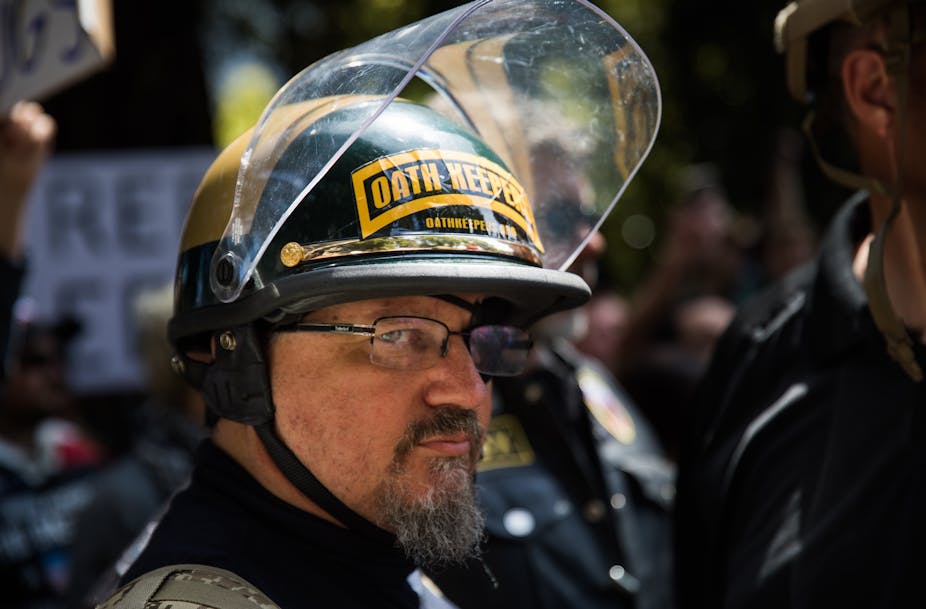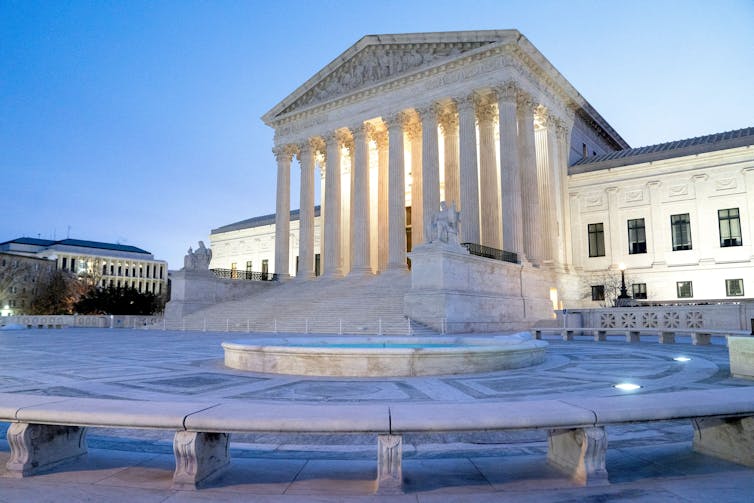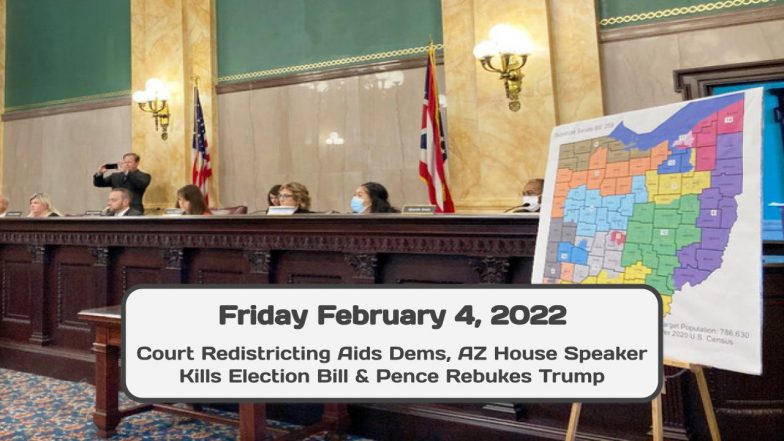News
Politico, – February 4, 2022
The redistricting wars are shifting into a new arena: the courtroom.
Most states have finished their maps already, but state and federal courts will direct the drawing of some 75 congressional districts in at least seven states in the coming months, marking a new phase in the process before the first 2022 primaries begin. In the next few weeks alone, North Carolina, Ohio and Pennsylvania courts are likely to impose new maps blocking Republican legislators’ attempts to relegate Democrats to small slivers of those congressional delegations.
Taken together, the court interventions have eased Democratic fears about redistricting as they sweat over a tough midterm political environment. So far, the decisions have validated the party’s state-by-state legal strategy and, critically, offered a surprising reprieve from several Republican gerrymandering attempts before a single election could be held under the new lines.
CNN, – February 4, 2022
A Republican bill that would have overhauled elections in Arizona — including giving the state legislature the power to reject election results — proved to be too much even for state GOP leaders this week.
Arizona House Speaker Rusty Bowers, a Republican, quietly doomed House Bill 2596 on Tuesday with an unusual parliamentary maneuver.
The speaker assigns all new bills to a committee for consideration before they can have full House votes, a choice that often has a great effect on a measure’s chance of success. But on Tuesday, Bowers took the unprecedented step of ordering all 12 House committees to consider the elections bill, virtually ensuring it will never reach the floor.
CNN,
Lake Buena Vista, Florida (CNN)Former Vice President Mike Pence called out his former boss by name on Friday, saying that “President (Donald) Trump is wrong” in claiming that Pence had the right to overturn the 2020 election on January 6, 2021.
Speaking at the Federalist Society Florida Chapters conference near Orlando, Pence delivered his strongest response yet to Trump’s ongoing efforts to relitigate the 2020 presidential election, calling it “un-American” to suggest one person could have decided the outcome.
Pence warned against conservatives who continue to insist the vice president can alter an election, and said it could be a problematic position for Republicans in the next presidential contest.
“Under the Constitution, I had no right to change the outcome of our election, and (Vice President) Kamala Harris will have no right to overturn the election when we beat them in 2024,” Pence said.
The Conversation, – January 27, 2022

Stewart Rhodes must stay behind bars until his trial. Philip Pacheco/Anadolu Agency/Getty Images
The leader of the Oath Keepers militia, Stewart Rhodes, must stay behind bars pending trial for his alleged role in the storming of the Capitol, a judge ruled on Jan. 26, 2022. While this means authorities can keep tabs on the whereabouts of Rhodes – and presumably limit any perceived threat from him – the same may not be said for all members of the group.
Rhodes and other defendants who have pleaded not guilty to charges of seditious conspiracy over the attempted insurrection on Jan. 6, 2021, present just a fraction of the total membership of the Oath Keepers – the size of which raises uncomfortable questions about the possibility of violent radicalization in the U.S. military.
As experts on violent extremism, we believe it isn’t only the number of Oath Keepers that is a problem, it is their makeup. A significant number of their members are veterans – both female and male – who bring military skills to the group and also serve as recruiters for other active and former armed service personnel.
Challenging the commander in chief
The Oath Keepers were founded by Rhodes in 2009 as an anti-government group in response to the Obama presidency.
The group’s name implies a mandate to honor their oath to the U.S. Constitution, and in particular to “defend the Constitution against all enemies, foreign and domestic.”
But its founding inspiration was precisely the opposite: challenging a legitimate president and commander in chief out of animosity toward what Barack Obama stood for. Since then, the Oath Keepers have armed and broadcast plans to mobilize.
The Oath Keepers may number in the thousands, yet we believe they present a greater threat than their membership suggests. This is partly because the Oath Keepers actively recruit current and retired members of the armed forces.
As UMass Lowell terrorism expert and our research collaborator, Arie Perliger, has shown in his work, Oath Keepers members are likely better trained militarily than other extremist groups because of the group’s composition.
About 10% of the Oath Keepers are active-duty military, and around two-thirds are retired military or law enforcement, according to analysis of the group’s membership by the Center for Strategic and International Studies. Several Oath Keepers present at the Jan. 6 attack were veterans, such as Larry Brock, the so-called “zip-tie guy” due to his being photographed with the makeshift handcuffs.
According to an analysis of court and Pentagon records by CNN, as many as 14% of those charged with crimes related to storming the Capitol served in the military. This is double the proportion of veterans in the general American adult population.
Military members are desirable to extremist groups because they bring special skills such as experience with weapons, targeting and combat experience. According to the indictment, the Oath Keepers used a “stack,” or staggered military formation, to breach the Capitol.
As our previous research demonstrated, the processes of radicalization in an extremist group movement is in many ways similar to military training. Those with military backgrounds possess not only the skills that radical groups seek, but also the psychological readiness for violent conflict that is rare among civilians.
The rise in radicalization within the ranks of the military can be observed in the increasing proportion of domestic terrorism acts in the U.S. involving active-duty and reserve personel, from 0% in 2018 to 1.5% in 2019 and 6.4% in 2020, according to the Center for Strategic and International Studies.
The number of Americans with military ties classified as extremists quadrupled in recent years, according to Michael Jensen and other researchers at the University of Maryland’s Study of Terrorism and Responses to Terrorism center.
Recruiting ground
An increase in radical ideology among members of the U.S. military makes it a fertile ground for recruiting by groups such as the Oath Keepers.
A 2019 poll of active-duty troops found that around 1 in 3 (36%) reported personally witnessing “White nationalism and ideologically-driven racism” among their peers. This included the use of racist language, but also swastikas drawn on service members’ cars and stickers supporting the Ku Klux Klan.
This high proportion reflects a significant increase from the previous year: In a 2018 poll, 1 in 5 (22%) active military troops had reported witnessing such behavior.
Why it matters
As well as posing a risk due to their weapons training, active and former military personnel pose a greater threat as members of right-wing militia groups. Unlike civilians, military people must take an oath, pledging allegiance to their country and the institutions of democracy enshrined in the Constitution.
When they align with groups like the Oath Keepers and plan an attack on the U.S. government, these military personnel betray their oath. This kind of hypocrisy is known in psychology as cognitive dissonance – an uncomfortable psychological state that arises when one’s actions contradict one’s self-image, causing a motivation to “double-down” to justify one’s actions. It is the reason that painful, embarrassing or humiliating initiation rites are often effective in radicalizing new members. The additional psychological cost of cognitive dissonance may mean military members of the Oath Keepers are more committed to their new allegiance after they turn away from their old one.
While the Oath Keepers wish to present themselves as the ultimate masculine alphas, some of the real power lies with the women supporting their efforts.
The number of men arrested over the Jan. 6 riot outnumber that of women. Of the 11 charged with seditious conspiracy, only one – Jessica Watkins, a former army ranger who at the time of the attack identified as an Oath Keeper – is a woman.
However, women play key support roles from behind the scenes, raising money, disseminating propaganda and even recruiting new members.
After Rhodes was arrested, Kellye SoRelle, a former attorney, was named as “acting president” of the Oath Keepers.
The hidden face of extremism is often female, as our previous research on the subject has shown. In Jihadi groups, women were crucial for fundraising, disseminating propaganda and recruiting men for the cause. Women in Jihadi organizations, like al-Qaeda recruiter Malika el Aroud, were able to shame men into participating in the conflicts in Iraq and Afghanistan.
On her website, minbar.sos, Aroud exhorted men to step up to prove that they were real men.
We see comparable dynamics in American right-wing extremist groups and the ways in which women weaponize toxic masculinity.
Some analysts have predicted that membership in the Oath Keepers will decline as a result of the indictments.
But those indicted number a only a few; the real concern is that the men and women who make up the Oath Keepers’ rank and file could continue to recruit while the leaders remain behind bars.
The Conversation, – January 28, 2022
The U.S. Supreme Court’s decision in Dobbs v. Jackson Women’s Health Organization will not be handed down until late spring or early summer 2022, when the court typically issues verdicts.
The potentially historic case challenges a Mississippi law banning most abortions after 15 weeks of pregnancy.
This case could overturn or uphold the 1973 Roe v. Wade decision, which protects women’s right to abortion before the third trimester of pregnancy.
There are other ongoing court challenges to restrict abortions in different states, including Texas. But this Mississippi case is arguably the most important abortion case since 1992, when the court last reaffirmed Roe v. Wade.
Scholars and experts have made various bold predictions about the Dobbs case.
But, as I have told students for more than a decade while teaching mass media law, guesses about Supreme Court rulings are often not correct.
What the experts are predicting
Supreme Court expert Ian Millhiser has speculated that the high court will either “explicitly overrule Roe” or “eliminate it in a more backhanded way.” This “backhanded way” could leave Roe’s precedent intact, but weaken it so states can legally restrict abortion as they see fit.
Attorney and political commentator Sarah Isgur also has written that the most likely outcome is the court overturning Roe. Abortion would then no longer be a constitutional right, and states could restrict or make abortion altogether illegal.
On the other hand, others have predicted the court “will vote to uphold the central holding of Roe.”

Look instead to statistical models
Research shows statistical models are more accurate than individual experts at predicting Supreme Court decisions.
The Supreme Court Forecasting Project was an academic initiative in the early 2000s that compared statistical models and independent legal experts forecasting Supreme Court decisions. The project found statistical models, on average, correctly predicted 75% of Supreme Court rulings during the 2002 term.
Legal experts were correct only 59% of the time for the same term, according to the Forecasting Project.
A 2017 study also used available data, like the background on cases, to retroactively predict Supreme Court decisions from 1815 to 2015. The complex model was correct 70% of the time. The project aimed to test quantitative approaches to legal predictions.
Meanwhile, there are Supreme Court followers who predict case decisions on the blog FantasySCOTUS.
One contributor to the site with no formal legal background correctly predicted Supreme Court decisions 80% of the time from 2011 to 2013, according to FantasySCOTUS.
This appears to be the exception.
Constitutional scholar Erwin Chemerinsky has noted some of the court’s unexpected recent decisions, such as Bostock v. Clayton County, which found that employment discrimination laws protect people based on sexual orientation and gender identity. Cases like this make it “dangerous to make predictions” about the court’s verdicts, Chemerinsky wrote.
Veteran Supreme Court reporter Ephrat Livni wrote that this kind of unpredictability is a good thing, showing the court “is working as it was designed to by the Constitution.”
One reason Supreme Court forecasts are often wrong? Justices stray from the public’s conception of their political ideologies, according to Livni.
Political ideology isn’t always guaranteed
Supreme Court decisions in National Federation of Independent Business v. Sebelius, which considered the Patient Protection and Affordable Care Act, and Bostock v. Clayton County, about employment protection for gay and transgender individuals, offer examples of how justices’ perceived politics did not align with their votes.
Initial predictions on whether President Barack Obama’s health care plan would survive a legal challenge were mixed, at best.
Law school professor Adam Winkler was among the experts who predicted the court would overturn the Affordable Care Act. They expected that Justice Anthony Kennedy, considered politically moderate, would not vote alongside liberal justices to protect the health care plan.
Meanwhile, Stanford law professor Hank Greely correctly predicted the court would uphold the Affordable Care Act. But he was not right when he suggested Chief Justice John Roberts would align with Kennedy for a 6-3 vote in support of the ACA.
The court ultimately ruled 5-4, supporting the Affordable Care Act’s requirement that most Americans must purchase health insurance or face a potential penalty. Roberts authored the opinion upholding ACA. This seemed to defy Roberts’ conservative ideology.
Many experts predicted the high court would vote against LGBTQ rights in the Bostock v. Clayton County case. The case consolidated three employment discrimination complaints made by gay and transgender individuals, and considered whether they are protected under Title VII of the 1964 Civil Rights Act.
Ultimately, Associate Justice Neil Gorsuch, whom President Donald Trump nominated in 2017, joined Roberts and the liberal justices for a 6-3 decision, affirming that Title VII protected people based on sexual orientation and gender identity.
Not one expert predicted Gorsuch would side with the liberal justices and write the majority opinion.
Gorsuch explained the law was clear: “An employer who fires an individual for being homosexual or transgender fires that person for traits or actions it would not have questioned in members of a different sex. Sex plays a necessary and undisguisable role in the decision, exactly what Title VII forbids.”
Looking ahead to Dobbs
The court upheld Roe v. Wade in 1992, but it also set a new standard for judging abortion laws. Former justice Sandra Day O’Connor co-authored the Planned Parenthood v. Casey opinion. She wrote that state laws that create an “undue burden” on women seeking abortion are illegal.
More important than the new “undue burden” standard, however, are the court’s overall reasons for upholding Roe.
While conceding Roe was controversial, O’Connor wrote that a woman relies on the right to abortion to “retain the ultimate control over her destiny and her body.” O’Connor also declared that Roe’s uniqueness “has a dimension not present in normal cases and is entitled to rare precedential force to counter the inevitable efforts to overturn it.”
The current court would have to argue O’Connor’s reasons for upholding Roe are obsolete to justify overturning the 50-year-old precedent.
So, as anticipation grows about how the Supreme Court will vote on abortion rights, it would be wise to not become be overly concerned about expert predictions. The chances are good that the experts will not get it right.
CNN, – February 4, 2022
Beijing (CNN)Russian President Vladimir Putin and Chinese President Xi Jinping issued a call for NATO to halt further expansion during a meeting on the sidelines of the Beijing Olympics on Friday, according to a joint statement released by the Kremlin.
The two leaders’ summit, held on the day of the Opening Ceremony for the Winter Olympics in China’s capital, marked a further step in what has become an increasingly close partnership between Beijing and Moscow, as relations with the West deteriorate for both.
According to an English-language version of the joint statement released by the Kremlin, the two countries “believe that certain States, military and political alliances and coalitions seek to obtain, directly or indirectly, unilateral military advantages to the detriment of the security of others.”
ABC News – February 4, 2022 (03:01)
February 4, 2022 – 12:00 pm (ET)
February 4, 2022 – 1:00 pm (ET)
February 4, 2022 – 1:00 pm (ET)
February 4, 2022 – 2:30 pm (ET)

